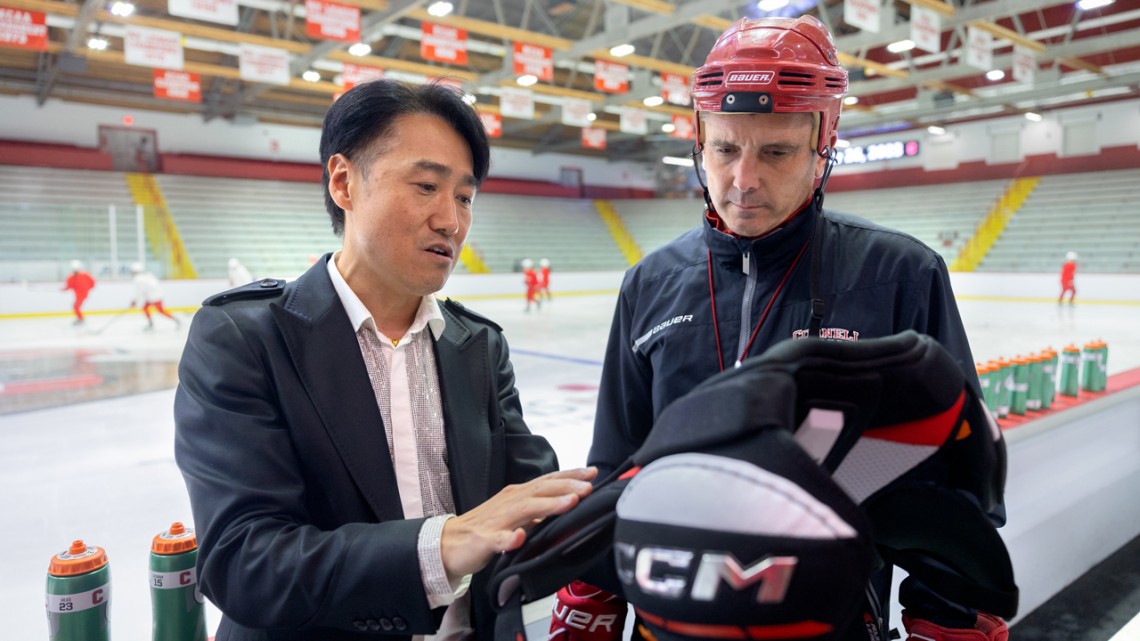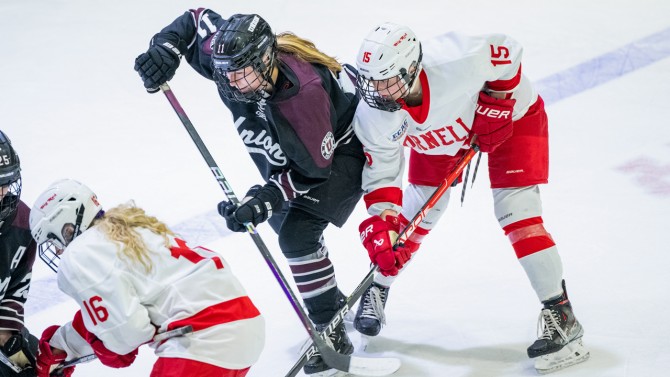
Heeju Park, associate professor of apparel design, speaks with Doug Derraugh ’91, the Everett Family Head Coach of Women’s Ice Hockey, about hockey protective equipment ahead of practice at Lynah Rink.
Researchers have designs on better women’s hockey protective gear
By Tom Fleischman, Cornell Chronicle
The website for Bauer, one of the biggest names in ice hockey equipment and apparel, lists 26 options for shoulder pads, which offer shoulder and upper torso protection for players in what can be a very fast and dangerous sport.
Of those 26 styles for youth and adults, exactly one is made specifically for women. The other major player in hockey gear, CCM, also has just one women’s model advertised on its site.
“It is shocking that the men have so many options and the women have just one,” said Tulasi Elangovan, M.A. ’23, a former member of the Performance Apparel Design Lab, directed by Heeju Park, associate professor of apparel design in the College of Human Ecology (CHE).
Though not a hockey person, Elangovan decided to make this problem hers, too. Part of her motivation: the fact that, according to USA Hockey, the increase in female registrants in 2017-18 outpaced their male counterparts by more than 7 to 1.
“That’s just such an inequality in the market,” Elangovan said, “especially when women’s ice hockey is actually growing at a much faster rate than men’s.”
Last year, while pursuing her master’s in apparel design, Elangovan dedicated many months to researching and designing a prototype for a shoulder pad made especially for women. That design, informed by contributions from the nationally ranked Cornell women’s hockey team, is being considered for possible patent protection by Center for Technology Licensing (CTL), with whom Park has worked closely for several months.
After Elangovan graduated, another member of Park’s lab, master’s student Huieun Do, joined the project; Do is focusing on improving design and function of lower-body (thigh to ankle) protective gear.
According to Ryan Luebke, associate director of business development and licensing at CTL, Elangovan and Park have a good chance of obtaining design patent protection, for which they’ll be applying in the coming months.
Addressing a problem
Elangovan’s involvement in a sport about which she knew very little began after Doug Derraugh ’91, the Everett Family Head Coach of Women’s Ice Hockey, read a Cornell Chronicle story about wearable sensors that could be used to measure motion, respiration and fatigue in athletes, with the aim of reducing injuries and improving training and performance.
“I thought, man, that would be interesting for a coach, if you had material in an athlete’s clothing that could actually measure vital statistics and things,” said Derraugh, a former high-scoring forward for the Cornell men’s hockey team who played professionally in Europe for 13 years before returning to his alma mater in 2005.
Derraugh paid a visit to Park to inquire about wearable sensors, and Park told him about Elangovan and her work.
“We started talking about how wearable technology could become part of a training outfit or a formal ice hockey uniform,” Park said. “And then he talked about a lot of issues – his players are suffering from injuries, as well concern and anxiety because it’s a very tough game, it’s a contact sport, and the gear, the skate blade, it can all be very dangerous at some point.”
Elangovan said that when she looked into women’s hockey equipment more closely, “I realized that this is an area that I could explore and that needed exploration, and some sort of research and development.”
For female athletes in contact sports, a particularly vulnerable area is the breasts, which are highly susceptible to injury due to their location and the lack of musculoskeletal protection.
Elangovan began by interviewing nearly a dozen members of the Big Red women’s team, whom she found supportive, enthusiastic and helpful.
“It just made it easier to approach the project,” she said of the team’s willingness. “I wanted to make sure that I went in with zero assumptions, that nothing was a given, and that if there was something from the feedback that they gave me that was unexpected, that would become a key part of the study itself.”
“Being that we usually wear equipment designed for men, it’s not as slim-fitting for women or accommodating for the different body types,” said the 5-foot-11 Rory Guilday ’25, who won gold with Team USA at the 2023 International Ice Hockey Federation Women’s World Championships, in April in Brampton, Ontario.
“Sometimes, if you want more protection, you’ll go for a bigger size,” said Guilday, one of the team’s three captains. “But then it doesn’t fit somewhere else.”
“I would say the biggest problem is that protective gear just has never been made considering the difference in anatomy, which is kind of crazy considering there’s a pretty big difference,” said 5-foot-3 Ashley Messier ’25, who also plays defense and is a team captain. “We just never really knew any better. We just wore the equipment, not really realizing that it could be a lot more efficient and comfortable and protective.”
Full-body 3D scans
After conducting player interviews, Elangovan invited team members to the Digital Fashion & Body Scan Research Lab, run by Fatma Baytar, assistant professor of human centered design (CHE). The lab has a full-body scanner that uses eight cameras and four eye-safe lasers to capture about 300,000 data points for each scan.
According to Park, the scans pointed to a key difference related to the fit of shoulder pads for men and women.
“We realized that in people of the same body height, the female torso is shorter than the male torso,” he said. “It’s a statistically significant difference that plays a critical role in enhancing protection, mobility and comfort for female players.”
Elangovan did numerous scans for each of the participating players, and those images helped her come up with a women’s shoulder pad design that she thinks will offer a better fit for the contours of the female body, along with greater protection.
A good fit is not only protective, Elangovan said, but it helps players concentrate on the ice.
“You want to make sure that the gear that you’ve given the players can protect them from all sorts of impact,” she said. “That’s the only way that these players can actually perform at their maximum capacity; otherwise, they’re going to be worried about slippage of gear, or something getting caught in another player’s stick, or the puck getting somewhere it shouldn’t. All of these are things that are going to detract from the players’ performance and confidence.”
The Big Red players praised Elangovan’s work and dedication.
“She was great,” said forward Abby Ruggiero ’24. “It was cool to see someone in her field look at athletics in a different light, and actually go to work on it. I feel like we talk about (equipment) but no one ever does anything about it, and she did.
“Now I’m rethinking my equipment,” she said, “and how it should fit me. It was cool to have her walk in and kind of look at it from a different perspective.”
“She did a great job, especially considering she didn’t have a background in hockey,” said Messier, whose father and uncle played briefly in the NHL and whose second cousin is Hockey Hall of Famer Mark Messier. “It didn’t really seem to matter; she was very diligent. She took our feedback and what we had experienced, and really applied it very well.”
Derraugh, who has been on the Team Canada coaching staff at Winter Olympics and World Championship tournaments, was happy to be a part of the project.
“You’re always looking for opportunities to give back and help the female game, whether that’s promoting it or helping it be better from an equipment standpoint,” he said. “The game is getting faster, and allowing more and more contact. The equipment should be better, as well.”
Media Contact
Get Cornell news delivered right to your inbox.
Subscribe

